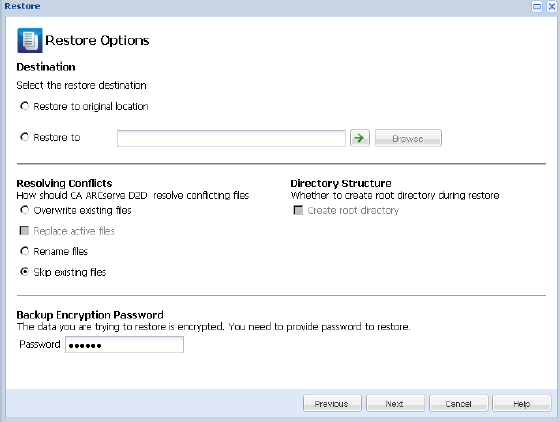

After you specify a recovery point and content to restore, define the copy options for the selected recovery point.
Follow these steps:

The available destination options are:
Restores to the original location from where the backup image was captured.
Restores to the specified location. You can click the green arrow button to verify the connection to the specified location. If necessary, enter the Username and Password credentials to gain access to that location.
The available options are:
Overwrites (replaces) any existing files, which are at the restore destination. All objects are restored from the backup files regardless of their current presence on your computer.
Replaces any active files upon reboot. If during the restore attempt CA ARCserve D2D discovers that the existing file is currently in use or being accessed, it will not immediately replace that file, but instead to avoid any problems will delay the replacement of the active files until the next time the machine is rebooted. (The restore occurs immediately, but the replacement of any active files is done during the next reboot).
This option is only available if you select the “Overwrite existing files” option.
Note: If you do not select this option, any active file is skipped from the restore.
Creates a new file if the file name already exists. Selecting this option copies the source file to the destination with the same filename but a different extension. Data is then restored to the new file.
Skips over and not overwrite (replace) any existing files that are located at the restore destination. Only objects that are not currently existing on your machine are restored from the backup files.
Default: Skip existing files.
Specifies that if a root directory structure exists in the captured backup image, CA ARCserve D2D recreates that same root directory structure on the restore destination path.
With this option not selected, the file or folder is restored directly to the destination folder.
For example, if during the backup you captured the files "C:\Folder1\SubFolder2\A.txt" and "C:\Folder1\SubFolder2\B.txt" and during the restore you specified to the restore destination as "D:\Restore".
With this option selected, the entire root directory path for the files/folders (including the volume name) is recreated to the destination folder. If the files/folders to be restored are from the same volume name, then the destination root directory path does not include that volume name. However, if the files/folders to be restored are from different volume names, then the destination root directory path does include the volume name.
For example, if during the backup you captured the files "C:\Folder1\SubFolder2\A.txt", "C:\Folder1\SubFolder2\B.txt", and also E:\Folder3\SubFolder4\C.txt" and during the restore you specified to the restore destination as "D:\Restore".
A password is not required if you are attempting to restore from the same CA ARCserve D2D computer from where the encrypted backup was performed. However, if you are attempting to restore from a different CA ARCserve D2D computer, a password is required.
Note: A clock icon with a lock symbol indicates the recovery point contains encrypted information and may require a password for restore. If you have previously entered an encryption password for this recovery point, CA ARCserve D2D stores this password in a key management database. When called upon, this password is retrieved and applied to the recovery point to be restored. If the password cannot be retrieved, a pop-up dialog appears, requesting you to enter a valid password. (The password may not be retrieved if CA ARCserve D2D has been reinstalled or if you want to restore an old recovery point or a recovery point of another machine).
The Restore Summary dialog opens.
The restore options are defined to restore from a recovery point.
|
Copyright © 2013 CA.
All rights reserved.
|
|